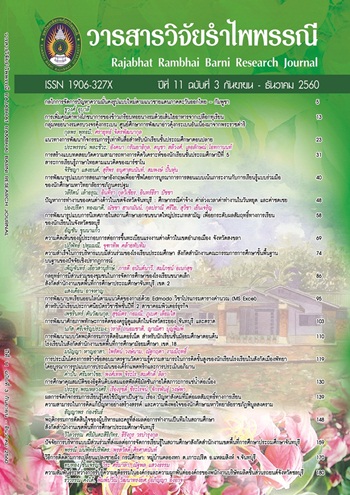THE CONSTRUCTION OF “ANALYTICAL THINKING ABILITY” TEST FOR GRADE 5, STUDENTS IN THAI LANGUAGE SUBJECT ACCORDING TO MARZANO’S TAXONOMY
Main Article Content
Abstract
The purposes of research were to construct, to test the quality of test, and to determine norms of analytical thinking ability test for grade 5 students in Thai Language Subject according to Marzano’s taxonomy. The sample was 860 grade 5 students in the second semester of academic year 2013 under Sa-keao Primary Educational Service selected by simple random sampling technique. The research process consisted of three phases:
Phase one: The test construction of analytical thinking ability test for grade 5 students in Thai Language Subject according to Marzano’s taxonomy in 5 skills subtest; Matching, classification, error analysis, generalizing and specifying.
Phase two: Validating the quality of the developed analytical thinking ability test comprised of the following activities obtaining the IOC value from experts, finding difficulty level, discrimination power, reliability and construct validity by comfirmatory factor analysis.
Phase three: Norms construction of analytical thinking ability test for grade 5 students. Local norm by modifying points raw to percentile.
The research findings were that; Analytical thinking ability test for grade 5 students possessed good quality. The content validity of this test, according to the finding from experts’ validation, were that there was congruence of indicator and the content between .60-1.00. The item difficulty between .20-.79. The item discrimination was between .08-.72. The reliability of the test was .81. The concurrent validity by Pearson’s correlation coefficient was .83. The construct validity of the test was confirmed by factor analysis confirmed that the model fitted well with the empirical data of the analytical thinking ability test. The goodness of fit measures for model were = 2660.857,
p = .00, RMSEA = .019, GFI = .840, AGFI = .828, CFI = .979 and RMR = .010. Thus the model fit well with the empirical data. The result norm of the analytical thinking ability constructed were as followed, The norms of analytical thinking ability test of grade 5 students in Thai Language strand according to Marzano’s taxonomy was found to have raw scores from 13-71 with the percentile from .37-99.87
Article Details
References
2. กระทรวงศึกษาธิการ. (2553). แนวปฏิบัติการวัดและประเมินผลการเรียนรู้หลักสูตรแกนกลางการศึกษา ขั้นพื้นฐาน พุทธศักราช 2551. กรุงเทพฯ: โรงพิมพ์ชุมนุมสหกรณ์การเกษตรแห่งประเทศไทย.
3. เกรียงศักดิ์ เจริญวงศ์ศักดิ์. (2546). การคิดเชิงวิเคราะห์. กรุงเทพฯ: ซัคเซสมีเดีย.
4. ชูศรี วงศ์รัตนะ. (2553). เทคนิคการใช้สถิติเพื่อการวิจัย. พิมพ์ครั้งที่ 12. นนทบุรี: ไทเนรมิตกิจ อินเตอร์ โปรเกรสซิฟ จำกัด.
5. เชิดศักดิ์ โฆวาสินธุ์. (2540). การพัฒนาคุณภาพการคิด. วารสารการวัดผลการศึกษามหาวิทยาลัยศรีนครินทรวิโรฒ.
6. ทิศนา แขมมณี. (2540). แบบแผนและเครื่องมือการวิจัยทางการศึกษา. กรุงเทพฯ: สำนักพิมพ์แห่งจุฬาลงกรณ์มหาวิทยาลัย.
7. ทิศนา แขมมณี. (2544). วิทยาการด้านการคิด. กรุงเทพฯ: สถาบันพัฒนาคุณภาพวิชาการ.
8. ทิศนา แขมมณี และคณะ. (2540). ทฤษฎีการเรียนรู้เพื่อพัฒนากระบวนการคิด. กรุงเทพฯ: สำนักงานคณะกรรมการการศึกษาแห่งชาติ.
9. ทิศนา แขมมณี, พิมพันธ์ เดชะคุปต์, ศิริชัย กาญจนวาสี, ศรินธร วิทยะสิรินันท์ และนวลจิตต์ เชาวกีรติพงศ์. (2540). ทฤษฎีการเรียนรู้เพื่อพัฒนากระบวนการคิด. กรุงเทพฯ: สํานักงานคณะกรรมการการศึกษาแห่งชาติ สํานักนายกรัฐมนตรี.
10. นงลักษณ์ วิรัชชัย. (2537). ความสัมพันธ์โครงสร้างเชิงเส้น (LISREL): สถิติวิเคราะห์สำหรับการวิจัยทางสังคมศาสตร์และพฤติกรรมศาสตร์. พิมพ์ครั้งที่ 2. กรุงเทพฯ: โรงพิมพ์จุฬาลงกรณ์มหาวิทยาลัย.
11. นงลักษณ์ วิรัชชัย. (2542). สถิติวิเคราะห์สำหรับการวิจัย. พิมพ์ครั้งที่ 3. กรุงเทพฯ: โรงพิมพ์จุฬาลงกรณ์ มหาวิทยาลัย.
12. บุญเชิด ภิญโญอนันตพงษ์. (2545). การพัฒนาเครื่องมือสำหรับการประเมินการศึกษา.นนทบุรี: มหาวิทยาลัยสุโขทัยธรรมาธิราช.
13. ประพันธ์ศิริ สุเสารัจ. (2551). การพัฒนาการคิด. กรุงเทพฯ: ศูนย์หนังสือจุฬาลงกรณ์มหาวิทยาลัย.
14. ประพันธ์ศิริ สุเสารัจ. (2552). แบบฝึกทักษะการคิดวิเคราะห์ระดับประถมศึกษาตอนปลาย.
15. สุรีพร อนุศาสนนันท์. (2554). การวัดและประเมินในชั้นเรียน. ชลบุรี: เก็ทกู๊ดครีเอชั่น.
16. สำนักงานรับรองมาตรฐานและประเมินคุณภาพการศึกษา (องค์การมหาชน). (2555). ผลการประเมินคุณภาพการศึกษาตามมาตรฐานการศึกษาขั้นพื้นฐานรอบสอง. เข้าถึงได้จาก www.onesqa.or.th/th.
17. ศิริชัย กาญจนวาสี. (2552). ทฤษฎีการทดสอบแบบดั้งเดิม. พิมพ์ครั้งที่ 6. กรุงเทพฯ: โรงพิมพ์แห่งจุฬาลงกรณ์ มหาวิทยาลัย.
18. Kline, P. (2000). Handbook of psychological testing (2nd ed.). London: New Fetter Lane.
19. Lumpkin. Cynthai Rolen. (1991). Effect of Teaching Critical Thinking Skill on the Critical Thinking Ability, Achievement, and Retention of Social Student Content by Fifth and Six-graders, Dissertation Abstracts.
20. Marzano , Robert J. (2001). Designing A New Taxonomy of Educational Objectives. California: Corwin Press.


